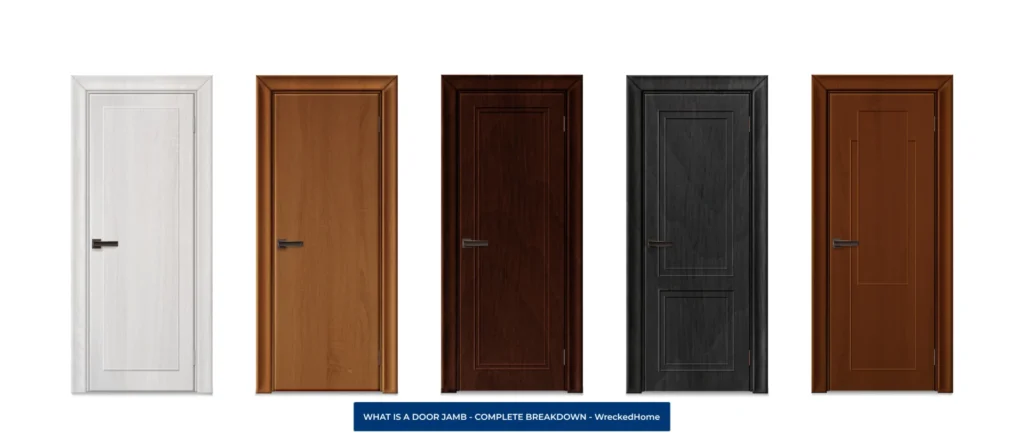A door jamb is more than just a passive component of your doorway, The door jamb quietly supports the structural integrity of the door. So, what is a door jamb? It is a frame surrounding a door that comprises of vertical side jambs and a horizontal head jamb to your door.
Its necessary to know the anatomy of the door jamb for anyone seeking a comprehensive grasp of door components. If you want to make your home or indoor security more secure then you should ensures that your door swings effortlessly and securely locks in place.
To assist you in this regard here is a guide all about door jambs. This guide will provide complete information about their types, components, and the crucial functions they perform in enhancing both the aesthetics and functionality of your entryways.
What is a Door Jamb?

One of the best functions of the door jamb is that it stands as the framework that defines a door’s stability and functionality. It consists of several components that are vertical and horizontal elements that encase a door. These essential parts provide support and structure. Here is a breakdown of this structure:
1. Vertical elements: Side jambs
The vertical part of the door frame, known as side jamb, play important roles in support. It acts as a pillar on either side of the door to anchor the door in place and contributes significantly to its overall stability.
2. Horizontal elements: Head jamb
The door header support is provide by horizontal elements called the head jamb. The head jamb not only gives support to the door but it also keeps the structure alignment stable. It also allows the door to swing smoothly and securely within the frame of the door.
3. Threshold and sill components
If you are new in door jamb assembly then you need to know the threshold and sill components. The sill is at the bottom of the door frame and is at the very bottom of the door jamb. This component is important because it protects the door from leaking and weather elements. The sill, situated beneath the threshold, reinforces the door’s foundation, is a way to add high end support and insulation.
These three components collectively form anatomy of the door jamb that influences the door’s functionality, security, and energy efficiency. Understanding these elements provides a holistic view of the door’s framework that enhances performance and longevity if offer required maintenance.
Types of Door Jambs

There are various types of door jambs that allow us to understand what is a door jamb. Its customization allows catering according to individual preferences and project requirements. There are different choices you can pick from. Each one is different depending on your need. The three types of door jambs are listed below.
- Pre-hung Door Jambs: These door jambs are engineered for efficiency during installation. This type of door jamb is pre-attached to the door frame. They are also convenient for anyone to install.
- Split Door Jambs: Designed for easy door replacement without the necessity of changing the entire frame split door jambs bring a level of flexibility to maintenance. It is most updated and easy to handle cost-effective option.
- Exterior Door Jambs: Crafted from durable and robust materials, exterior door jambs are durable and can bear any weather condition. These jambs go beyond mere aesthetics; and offer security along with longevity.
Selecting the appropriate door jamb depends upon the crucial factors like construction type and aesthetic preferences. In modern homes, the need for a sleek metal door jamb might complement the minimalist design, while providing for traditional homes as well. At that point, wooden door jamb are firmly linked with more fitting details.
Materials Used in Door Jambs
In any home, interior or exterior products material matter a lot. When it comes to door jambs, the choice of material significantly impacts the visual appeal along with overall performance and durability.
1. Wood Door Jambs
From traditional to advanced age, wooden door jambs remain a classic and popular choice. The importance of this door is their timeless appeal and versatility. Because of warmth and grain pattern, natural characteristics of wood give a touch of elegance to any space.
Another likable thing of this wood frame is customization that allows for intricate detailing that complements various architectural styles. But, you need to take care of it for longevity due to susceptibility to moisture.
2. Metal Door Jambs
On the other hand, the metal door jamb is known for its unmatched strength and durability. The basic material consists on steel or aluminum. These jambs offer robust support, ensuring enhanced security. It is widely used in moisture and insect abundant settings. Due to their fire-resistant ability, they add an extra layer of safety to the structure.
3. Composite Door Jambs
Composite door jambs are a combination of collective strengths of various materials that make it durable and long-lasting. Due to this combination of fibers, resins, and other materials it resists moisture, decay, and insect damage.
With higher durability, it meets the outdoor environmental circumstances. The composite material’s stability ensures minimal warping or swelling that increases the lifespan for the door jamb.
So you can choose the right material for door jambs, by focusing on aesthetics, maintenance requirements and environmental factors. These are key elements to achieve a harmonious balance between form and function.
Common Function of Door Jambs
Door jambs, often overlooked, provide basic and foremost structural support to a door. They enhance security, ensure proper door alignment, and provide stability that makes them unsung heroes of a door. It is important to the functions of door jamb for those who want to know what is a door jamb
Let’s break down the basic functions
Alignment and Stability: The basic function of the door jamb is the support system to maintain the alignment of the door. Door jambs ensure that the door swings smoothly on its hinges, that is surety of stability and prevent from collapse.
-
- Security Enhancement: Indoor security is a main concern to install the door. Door jambs play a crucial role in fortifying the security of living space. They provide a solid frame for the door that resists any forced attempt when door is closed.
-
- Insulation and Energy Efficiency: By sealing the gaps between the door and the surrounding structure, door jambs contribute to insulation. This helps in maintaining a consistent indoor temperature and enhances energy efficiency by preventing drafts.
-
- Noise Reduction: Besides the structural support, another value added benefit of door jambs is minimizing noise transmission between rooms or from the external environment. This is particularly significant in maintaining privacy and making environments more comfortable.
-
- Weather Resistance: Exterior door jambs often exposed to severe weather conditions require durability. They act as a barrier against rain, wind, and other environmental factors, to withstand harsh weather conditions.
-
- Aesthetic Enhancement: Beyond functionality, door jambs contribute to the overall aesthetics of a door because it surrounds the door like a photo frame. The choice of materials, finishes, and designs allows for customization, and make your indoor more appealing.
Understanding these multifaceted functions highlights the pivotal role of door jambs to ensure the longevity, security, and efficiency.
Installation Process of a Door Jamb
Installing a door jamb is a crucial step as it is required for proper functionality and longevity. A meticulous approach to the installation process is necessary if you want to know what is a door jamb. It consists of the following steps
-
- Preparation: Before proper installation, you need to do proper preparation. Gather all necessary tools and materials. These typically include the basic tools that are a level, tape measure, saw, screws, shims, and a drill. You must ensure that the work area is clean and free from debris.
-
- Measuring and Cutting: Accurate measurements are a key of successful installation for the door jamb. The basic element of measurement is height and width, accounting for any variations in the flooring. Based on these measurements, you need to use a cutter to cut the side jambs to the appropriate length and the head jamb to the width of the door.
-
- Attaching the Jambs: Start by positioning the side jambs vertically on either side of the door opening to make your door fix. Use a level to ensure they are plumb and shim as necessary to correct to avoid any mishap in alignment. Secure the side jambs to the wall framing with screws, before starting final fixation. Subsequently, affix the head jamb horizontally above the door, and then you need to verify the level.
-
- Securing the Threshold: The threshold, positioned at the base of the door jamb, requires secure placement to thwart drafts and ensure an effective seal. Secure it to the floor, making necessary adjustments as needed to accommodate variations in flooring height.
Throughout the installation process, you need to follow the expert guidelines and instructions. To make the proper installation, you must check alignment and levelness at each step, making adjustments as necessary.
By following these steps you can achieve a professionally installed door jamb that not only enhances the door’s functionality but also increase the visual appeal.
Conclusion
In unraveling the secret of support behind door its necessary to know what is a door jamb? From shaping a door’s functionality, security, and aesthetic impact the outer frame structure is the basic element. This door jamb is known as a frame that emerges as a linchpin in the architectural narrative. With different materials, it comes with three types that ensures to with stand in respective settings.





































